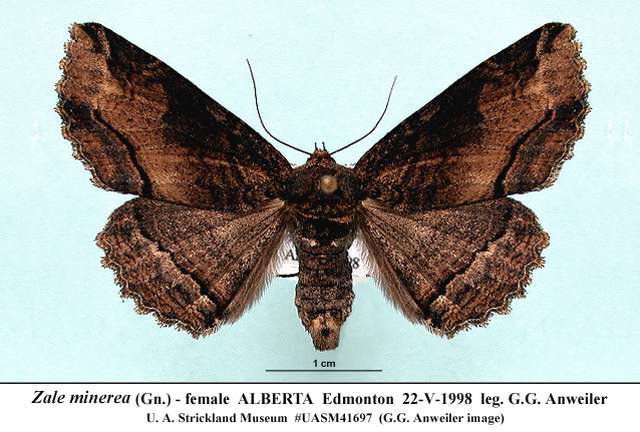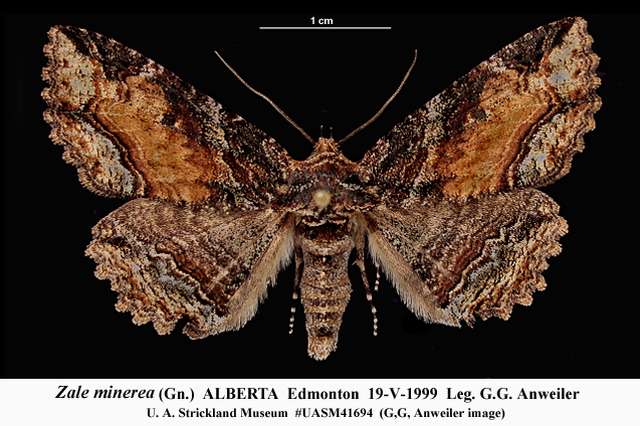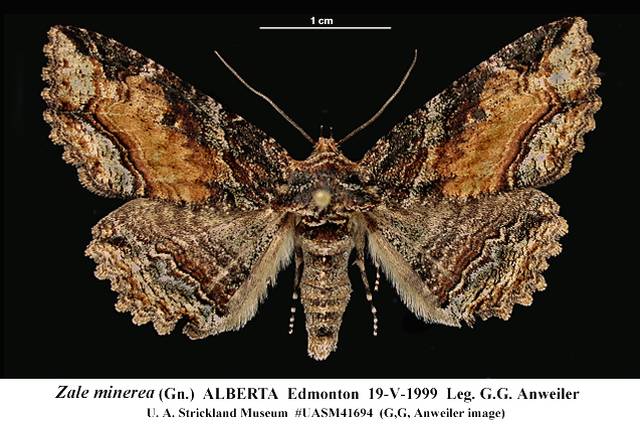Species Details
Zale minerea
University of Alberta E.H. Strickland Entomological Museum Read more about this collection »
Common NameMahogany Similar-wing, Colorful Zale
SeasonalityIn Alberta adults have been collected from late April through early July.
IdentificationA medium-size (3.5-5.0 cm wingspan) broad-winged moth. Color quite variable in both sexes. The FW of females is dark chocolate brown, almost black in the basal and costal one-third, paler and red-brown in the outer half. The ST line is black and well defined along the lower two-thirds, darker distally except for apex region. HW chocolate brown striated with many faint black bands, and with a nearly straight black line with paler yellow brown scaling along the outer edge crossing the outer third. Both wings moderately scalloped. Male smaller, brighter. Basal one quarter and costa dark brown, most of median area bright red-brown or mahogany, separated from the basal area by a lighter grey band. The terminal area is light yellow-brown or cream divided into an upper and lower patch. HW like female but lighter brown, and with a pale patch on the lower one-third. Antennae simple.
Similar-wings greatly resemble geometrid moths, both in their unusually patterned HW and their habit of resting flat with wings partially opened. The Mahogany Similar-wing is very similar to the Lunate Similar-wing (Z. lunata)which, although not yet taken in Alberta, occurs both to the east and west and should be watched for. Questionable specimens should have their identity confirmed by examining the genitalia. Alberta specimens are referable to ssp. norda, a brighter form, named from southern Alberta material.
Scientific Name
Zale minerea
Common Name
Mahogany Similar-wing, Colorful Zale
Habitat
Deciduous and mixedwood woodland.
Seasonality
In Alberta adults have been collected from late April through early July.
Identification
A medium-size (3.5-5.0 cm wingspan) broad-winged moth. Color quite variable in both sexes. The FW of females is dark chocolate brown, almost black in the basal and costal one-third, paler and red-brown in the outer…
A medium-size (3.5-5.0 cm wingspan) broad-winged moth. Color quite variable in both sexes. The FW of females is dark chocolate brown, almost black in the basal and costal one-third, paler and red-brown in the outer half. The ST line is black and well defined along the lower two-thirds, darker distally except for apex region. HW chocolate brown striated with many faint black bands, and with a nearly straight black line with paler yellow brown scaling along the outer edge crossing the outer third. Both wings moderately scalloped. Male smaller, brighter. Basal one quarter and costa dark brown, most of median area bright red-brown or mahogany, separated from the basal area by a lighter grey band. The terminal area is light yellow-brown or cream divided into an upper and lower patch. HW like female but lighter brown, and with a pale patch on the lower one-third. Antennae simple.
Similar-wings greatly resemble geometrid moths, both in their unusually patterned HW and their habit of resting flat with wings partially opened. The Mahogany Similar-wing is very similar to the Lunate Similar-wing (Z. lunata)which, although not yet taken in Alberta, occurs both to the east and west and should be watched for. Questionable specimens should have their identity confirmed by examining the genitalia. Alberta specimens are referable to ssp. norda, a brighter form, named from southern Alberta material.
Life History
Adults are nocturnal and come to light. The larvae are solitary defliators. They overwinter in the pupal stage.
Conservation
A fairly common widespread species; no concerns.
Diet Info
A generalist feeder on flowering trees and shrubs (Miller and Hammond, 1998). No specific Alberta data; elsewhere a wide variety of deciduous shrubs and trees, including willows (Salix sp.), White birch (Betula…
A generalist feeder on flowering trees and shrubs (Miller and Hammond, 1998). No specific Alberta data; elsewhere a wide variety of deciduous shrubs and trees, including willows (Salix sp.), White birch (Betula papyrifera), hazel (Corylus), spruce (Picea sp.) and apple (Malus) (both foliage and fruit).
Range
Across southern Canada, west to Vancouver Island, north into the southern Boreal forest and south in the mountains. In Alberta it occurs from the Milk River in the extreme south north into the southern Boreal Forest…
Across southern Canada, west to Vancouver Island, north into the southern Boreal forest and south in the mountains. In Alberta it occurs from the Milk River in the extreme south north into the southern Boreal Forest (Redwater, Edmonton). Bowman (1951) recorded it only from Medicine Hat, and it has apparently moved into the Edmonton area since that time.
References
Author
Bowman, K.
Title
An annotated list of the Lepidoptera of Alberta.
Publication Date
1951
Series Title
Canadian Journal of Zoology
Volume
29
Pages
121-165
Author
Prentice, R. M.
Title
Forest Lepidoptera of Canada. (1962)
Publication Date
1962
Volume
2
Pages
281
Author
Forbes, William T. M.
Title
Lepidoptera of New York & neighbouring states : Part 3
Publication Date
1954
Series Title
Cornell University Agricultural Experiment Station. Memoir
Author
Miller, J. C. and P. Hammond
Title
Macromoths of the Northwest Forests and Woodlands.
Publication Date
2000
Pages
133
Specimen Information
There are 127 specimens of this Species.
UASM13970 - Zale minerea
University of Alberta E.H. Strickland Entomological Museum
Place CollectedCanada: Alberta, Medicine Hat
Collected ByBowman, K.
Date Collected1940-05-29
UASM7133 - Zale minerea
University of Alberta E.H. Strickland Entomological Museum
Place CollectedCanada: Alberta, Tofield
Collected BySchmidt, B. C.
Date Collected2000-06-04
UASM34352 - Zale minerea
University of Alberta E.H. Strickland Entomological Museum
Place CollectedCanada: Alberta, Edmonton
Collected ByLawrie, D.
Date Collected1998-06-07
UASM34360 - Zale minerea
University of Alberta E.H. Strickland Entomological Museum
Place CollectedCanada: Alberta, Edmonton
Collected ByLawrie, D.
Date Collected1998-06-05
UASM34365 - Zale minerea
University of Alberta E.H. Strickland Entomological Museum
Place CollectedCanada: Alberta, Edmonton
Collected ByLawrie, D.
Date Collected1998-06-14
UASM34370 - Zale minerea
University of Alberta E.H. Strickland Entomological Museum
Place CollectedCanada: Alberta, Edmonton
Collected ByLawrie, D.
Date Collected1995-06-10
UASM34372 - Zale minerea
University of Alberta E.H. Strickland Entomological Museum
Place CollectedCanada: Alberta, Edmonton
Collected ByLawrie, D.
Date Collected1998-06-11
UASM41690 - Zale minerea
University of Alberta E.H. Strickland Entomological Museum
Place CollectedCanada: Alberta, Moose Lake
Collected ByAnweiler, G. G.
Date Collected1996-06-16
UASM41691 - Zale minerea
University of Alberta E.H. Strickland Entomological Museum
Place CollectedCanada: Alberta, Wagner Natural Area
Collected ByAnweiler, G. G.
Date Collected2000-06-02
UASM41692 - Zale minerea
University of Alberta E.H. Strickland Entomological Museum
Place CollectedCanada: Alberta, Breed Creek
Collected ByPohl, G. R.
Date Collected1996-06-14
UASM41693 - Zale minerea
University of Alberta E.H. Strickland Entomological Museum
Place CollectedCanada: Alberta, Writing-On-Stone Provincial Park
Collected ByAnweiler, G. G.
Date Collected1999-06-15
UASM41694 - Zale minerea
University of Alberta E.H. Strickland Entomological Museum
Place CollectedCanada: Alberta, Edmonton
Collected ByAnweiler, G. G.
Date Collected1999-05-19
UASM41695 - Zale minerea
University of Alberta E.H. Strickland Entomological Museum
Place CollectedCanada: Alberta, Edmonton
Collected ByAnweiler, G. G.
Date Collected2000-06-02
UASM41696 - Zale minerea
University of Alberta E.H. Strickland Entomological Museum
Place CollectedCanada: Alberta, Edmonton
Collected ByAnweiler, G. G.
Date Collected2000-06-05
UASM41697 - Zale minerea
University of Alberta E.H. Strickland Entomological Museum
Place CollectedCanada: Alberta, Edmonton
Collected ByAnweiler, G. G.
Date Collected1998-05-22
UASM57977 - Zale minerea
University of Alberta E.H. Strickland Entomological Museum
Place CollectedCanada: Alberta, Edmonton
Collected ByAnweiler, G. G.
Date Collected2004-05-19
UASM57991 - Zale minerea
University of Alberta E.H. Strickland Entomological Museum
Place CollectedCanada: Alberta, Edmonton
Collected ByAnweiler, G. G.
Date Collected2004-05-16
UASM57992 - Zale minerea
University of Alberta E.H. Strickland Entomological Museum
Place CollectedCanada: Alberta, Edmonton
Collected ByAnweiler, G. G.
Date Collected2004-05-16
UASM57993 - Zale minerea
University of Alberta E.H. Strickland Entomological Museum
Place CollectedCanada: Alberta, Edmonton
Collected ByAnweiler, G. G.
Date Collected2004-05-16
UASM58009 - Zale minerea
University of Alberta E.H. Strickland Entomological Museum
Place CollectedCanada: Alberta, Edmonton
Collected ByAnweiler, G. G.
Date Collected2004-05-25
UASM58010 - Zale minerea
University of Alberta E.H. Strickland Entomological Museum
Place CollectedCanada: Alberta, Edmonton
Collected ByAnweiler, G. G.
Date Collected2004-05-27





